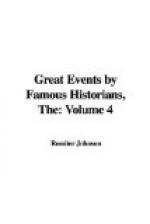Macaulay has startled many a reader of the most familiar histories of England, in saying, “Hengist and Horsa, Vortigern and Rowena, Arthur and Mordred, are mythical persons, whose very existence may be questioned, and whose adventures must be classed with those of Hercules and Romulus.” It is difficult to write of a period of which the same writer has said, “an age of fable completely separates two ages of truth.” Yet no one knew better than this accomplished historian himself that an age of fable and an age of truth cannot be distinguished with absolute precision. It is not that what is presented to us through the haze of tradition must necessarily be unreal, any more than that what comes to us in an age of literature must be absolutely true. An historical fact, a real personage, may be handed down from a remote age in the songs of bards; but it is not therefore to be inferred that these national lyrics are founded upon pure invention. It is curious to observe that, wandering amid these traces of events and persons that have been shaped into history, how ready we are to walk in the footsteps of some half-fabulous records, and wholly to turn away from others which seem as strongly impressed upon the shifting sands of national existence.
We derive Hengist and Horsa from the old Anglo-Saxon authorities; and modern history generally adopts them. Arthur and Mordred have a Celtic origin, and they are as generally rejected as “mythical persons.” It appears to us that it is as precipitate wholly to renounce the one as the other, because they are both surrounded with an atmosphere of the fabulous. Hengist and Horsa come to us encompassed with Gothic traditions that belong to other nations. Arthur presents himself with his attributes of the magician Merlin, and the knights of the Round Table. But are we therefore to deny altogether their historical existence? In following the ignis fatuus of tradition, the credulous annalists of the monastic age were lost in the treacherous ground over which it led them. The more patient research of a critical age sees in that doubtful light a friendly warning of what to avoid, and hence a guide to more stable pathways.
Hengist and Horsa—who, according to the Anglo-Saxon historians, landed in the year 449 on the shore which is called Ebbsfleet—were personages of more than common mark. “They were the sons of Wihtgils; Wihtgils son of Witta, Witta of Wecta, Wecta of Woden.” So says the Anglo-Saxon Chronicle, and adds, “From this Woden sprang all our royal families.” These descendants, in the third generation from the great Saxon divinity, came over in three boats. They came by invitation of Wyrtgeone—Vortigern—King of the Britons. The King gave them land in the southeast of the country, on condition that they should fight against the Picts; and they did fight, and had the victory wheresoever they came. And then they sent for the Angles, and told them of the worthlessness of the people and the excellences of the land. This is the Saxon narrative. The seductive graces of Rowena, the daughter of Horsa, who corrupted the King of the Britons by love and wine, is an embellishment of the British traditions.




